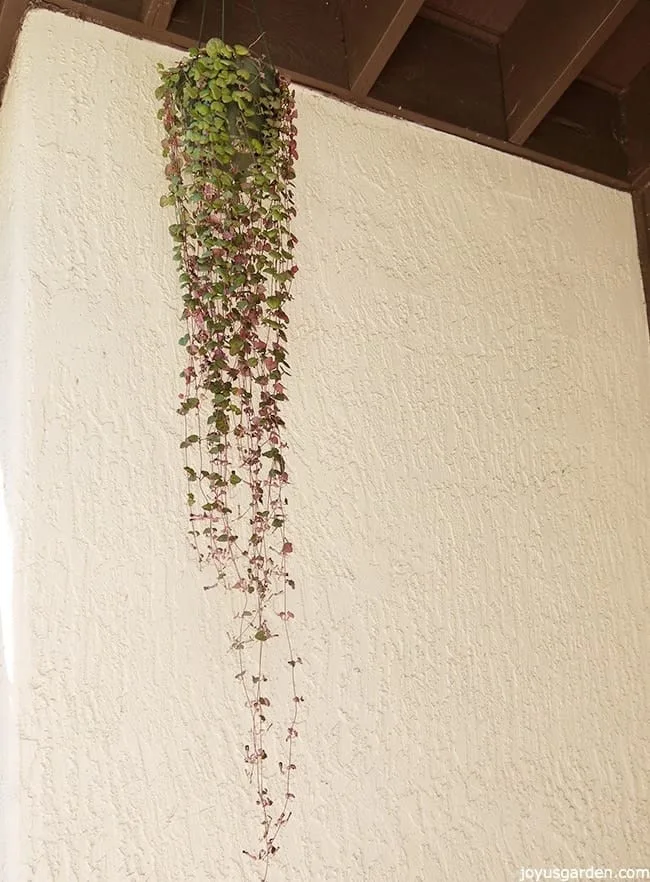How to Grow String of Hearts: A Sweet Succulent-Like Trailing Houseplant
Oh sweet little String Of Hearts, many people think you’re a succulent but you aren’t. This trailing houseplant is durable, easy as can be and the care is similar to a fleshy succulent but it shares the same family with another plant I love, the Hoya. They are both considered to be a succulent vine.
The botanic moniker is Ceropegia woodii but it also goes by Rosary Vine or Chain Of Hearts.

My Hoya, a cousin to the String Of Hearts, has grown like crazy so it’s time to repot that soon.
This unusual beauty with heart-shaped foliage, hence the name, came with me when I moved from Santa Barbara to Tucson. In the 4 months that I’ve lived here, this plant (which hangs in my pink grapefruit tree) has grown like the dickens. The trails were all about about 12″ long and now the longest are 43″. I’ve fast discovered that Rosary Vine loves the heat!
The Rosary Vine loves the heat but not direct sun.
Although a healthy String Of Hearts has a lot of foliage on many stems, it’s not a full and bushy vine. It stays on the wispy side but this, along with the flowers, are a big part of its appeal. Mine got hopelessly tangled on the 9 hour “car crammed full of plants drive” to my new home and that way it’ll stay. Tangles and all, it’s doing just fine.
Here are some things to know about the Rosary Vine:
Size:
The trails of a Rosary Vine can reach up to 12′ long in its natural habit. Usually when grown as a houseplant it doesn’t get much past 2′ long. Mine grows outdoors & is well on the way to 4′ long.
Exposure:
Indoors you want to give it very bight light with no direct sun. A west window is fine but just make sure it isn’t up against the hot glass. Outdoors I keep mine in bright shade with no direct sunlight – it grows under my pink grapefruit tree.
Water:
When grown as a houseplant, you want your String Of Hearts to dry out in between waterings. As I said, this plant isn’t technically a succulent but you want to treat it like 1. I was watering mine every other day here in the desert in those hot summer months but now it’s October (the highs are right around 90) & I’ve backed off to every 3-5 days. Give it too much water & kiss it goodbye!
Important to know: water even less in the winter because the Rosary Vine goes dormant.

My String Of Hearts is a trailing machine!
Hardiness:
Mine lived outdoors in Santa Barbara where the winter temps could dip into the high 30’s F, low 40’s. I read somewhere that it’s hardy to 25F so I plan on leaving outside here in Tucson & see what happens.
Soil:
A succulent & cactus mix is just fine. If you have some coco coir, your String Of Heats would love it added to the mix. Or, a combo of half cymbidium orchid & half succulent mixes would work fine too. Just make sure the mix drains really well.
Transplanting:
It’s best to transplant your Rosary Vine in spring or summer.
Fertilizer:
Like most of my plants, I top dress with worm castings in the spring. If you feel yours needs some feeding, then an application of balanced liquid houseplant fertilizer in spring would work too.
Flowers:
Yes it does! Mine started flowering at the end of summer & the blooms just keep on coming.

Here are those sweet but funny little flowers.
Pruning:
Not much of any is needed. I’ve only cut a few dead stems out. If yours gets leggy or you want to propagate it by cuttings, then you’ll need to prune.
Propagation:
The easiest ways are by stems cuttings & by laying the tubers right on top of a mix. They root very quickly.
Pests:
Mine has never had any but reportedly mealybugs can appear. Keep your eye out for aphids & scale also.
There are 2 reasons why people have trouble with the Rosary Vine: not enough light &/or too much water, especially in the winter months.
The String Of Hearts or Rosary Vine is a great trailing houseplant.
In warmer climates, you can grow it outdoors year round. There’s also a variegated form of it which has a touch of pink. I’m going to plant mine in a large hanging basket with String Of Pearls and String of Bananas. Stayed tuned for that post and video!
Happy gardening,


Just because … A butterfly enjoying my Red Bird Of Paradise.
If you like trailing succulents then check out Fishhooks Senecio, it’s very easy to grow!
YOU MAY ALSO ENJOY:
How Much Sun Do Succulents Need?
How Often Should You Water Succulents?
Succulent and Cactus Soil Mix for Pots






Hi Nell,
Nice job with your website. I’m a Hoya junkie so keep that kind of stuff a coming. THANKS!
Don
Thanks Don. I love them too but only brought 1 with me when I moved to Tucson. Mine is doing great so I may have to get more! Nell
Thank you for the instruction! My husband gave me my first “string of hearts in the very early years of our marraige and we have always had one sweet little pot through the years. 30+ years later and I am starting my 5th plant. Give care just as you have suggested (especially not to overwater) and they can live for years. Ours are so very special to us, I was delighted to find your info, thank you!
Elizabeth – You’re so welcome! Your String Of Hearts (& all its offspring) is so special. And talk about longevity! Thank you for sharing; others will be delighted to hear this. Happy gardening, Nell
Thank you for the instruction! My husband gave me my first “string of hearts” in the very early years of our marraige and we have always had one sweet little pot through the years. 30+ years later and I am starting my 5th plant. Give care just as you have suggested (especially not to overwater) and they can live for years. Ours are so very special to us, I was delighted to find your info, thank you!
I have a question? So its spring time and iv had my string of hreats for 4 years, i love it and im a afraid i killed it. Can they come out of not being waterered enough?
It depends on how far gone it is Haley. If the strings are completely brown & dead looking, then cut them back. It might rejuvenate from the roots. Nell
Nell,
Thanks for the great post. Very helpful. I have a question about moving since you mentioned it. Could you write another post with tips and tricks on how to move housplants so they won’t get ruined? Do you wrap them? Use some special containers? Any tips would be highly appreciated since I am dreading my move. Hint: I have a looooot of cacti, succulents, palm trees, you name it. True plant hoarder here. Thanks in advance!
Hi Tanya – You’re welcome! Moving is never easy, that’s for sure. Because I moved to a different state, I had to give most of my plants away because the movers wouldn’t take them (agricultural regulations). I took what few plants I could with me in my (rather small) car along with 2 cats. I didn’t wrap or box them but my neighbor helped me carefully pack them in. I’ve been in the pant biz for a long time & can tell you that the growers paper sleeve & box plants when they ship them; that’s it. Partitioned boxes, like those for wine, glasses, etc are great for smaller plants. As long as the plants are stable in their pots, they’ll be fine. Good luck with the move! Nell
Very informative… but I wanted to ask if it helps purify the air indoors
Thank you Kitty. All plants purify the air around them to a certain extent but there hasn’t been any practical studies done on this. I did a post on this subject recently & here are my thoughts after doing a little research: https://www.joyusgarden.com/how-well-do-houseplants-really-clean-the-air/ Best, Nell
hello nell, excellent info. i live in los angeles, ca and i’d love to place either string of pearls or strand of hearts in my kitchen window which faces west. because the overhang on my roof it gets a good amount of light but not direct sun. which of these plants do you think would sustain?
appreciate your input.
regards,
dee
Hi Dee – Thank you. That sounds like a great exposure for either SOH or SOP. I grow both of these plants in the same pot outdoors. In my opinion, String Of Hearts makes a better houseplant. Nell
Thank you for the info Nell, i’m bringing my plants in for the winter, and repotting some. I love this plant and mine has been overwatered and in a plastic pot, but I’ll let it dry out and hopefully get it
to give me some new plants eventually.
You’re welcome Christine. Mine is growing like crazy & I need to cut it back before the cool weather sets in. I’ll do a post & video so you can see what I do in case yours trails to 6′ like mine. Nell
Hi Nell, how does your rosary vine plant do outside during the winters in Tucson? I just bought one and am unsure if it’ll survive outside this winter! How frequently do you water during the winter with it living outdoors? I live in Mesa, AZ. Thanks so much and happy gardening!! -Miranda
Hi Miranda – You’re welcome. It does great in the bright shade & grows like crazy in the heat. Last winter was my 1st winter here in Tucson & I covered it with a large dish towel about 10 nights when the temps were dipping below 38-40 degrees. I water it twice a week in the summer & about every 10 -14 days in winter depending on the temps. Happy gardening to you up in Mesa! Nell
Hi Nell!
Living in New Mexico, my String of Hearts is thriving and has grown to almost 2′!
However, I have moved it around quite a bit and the stands have become very tangled. I know the plant is fine but I am dying to untangle it. I am tempted to cut it back and sort it out from there. Do you think this will hurt the poor thing?
Hi Lisa – My String Of Hearts got very tangled on the move from CA to AZ so I know what you mean! Mine was about 5′ long & I just cut it back to 2-3′. It’s still very thick & heavy so I’m going to try to thin it out a bit (good luck!). I took cuttings & am going to replant them soon. So, you might want to cut it back, root the cuttings & go from there because that’s what I may end up doing. I have a post & video coming on this in early 2018 so stay tuned. Nell
Hey Nell
I’ve just bought my first string of hearts and have done 2 cuttings right beside each other. 1 looks nice and healthy but the leaves on the other one are curling and I can’t seem to find any info on why that would be happening. Do you have any tips for me.
Thank you
Hi Tamara – SOP cuttings can do that sometimes. 9 will do fine & 1 won’t. By curling I’ll assume you mean shriveling. The mix is most likely too wet, especially if they’re green. I spray my SOP cuttings to prevent that. Shriveling can also be too dry – depends on how the pearls look. Nell
Help! I received a string of hearts as a Christmas present, and vines are dying off one by one. First the leaves wilt and then the whole vine dries off and dies. The plant is half the size it was a month ago. I only have one window in my apt., and it is hanging right in front of it. The light is weak but it is a West-facing window. To make up for the weak light I have a grow light on the plant. I only water it for two seconds once a week since it is winter and I live in a climate where it gets cold in the winter (east TN). The potting soil is a cactus mix with sand, and drains well. What can I do to keep the plant from dying? It has new growth, especially on the ends, but even the new growth is dying when the vine it’s on dies.
Hi Amelia – SOH likes bright natural light. Mine grows outdoors out of direct sun. Sounds like not enough light & too much water. It could have been wet from the get go & never dried out. Mine has grown so much & gotten very bare at the top so I’m cutting it all back. Stay tuned for that post. they do root readily in water. Nell
Hi Nell,
I live in SE Australia at about 2,000 feet and have 2 SOHs which are only 2-3 years old from purchase and have vines that are 5′ & 3′ respectively. They live outside from October through May (our seasons are reversed to yours) in a shaded courtyard and then come inside when the dewpoint starts to fall close to 4C (we live in a frost hollow, so our dewpoint will be closer to 0C). They both flower profusely and seem quite healthy.
My question for you is this sequence: what are the spear looking pods that they produce in the autumn? Are they actually seed pods and if so, can the seeds be harvested and if so how? Or, is propagation only possible via starts from the nodules?
Thanks,
Sully
Hi Sully – Yes, those are the seeds pods which are vaguely reminiscent of milkweed seed pods. I’ve never grown a String Of Hearts by seed (only by tubers & cuttings) so I can’t help you with that. Nell
Hi Nell 🙂
I have a small string of Heart plant, plus 1 cutting that’s now rooted.
My question is …
Can I spray water on the Heart leaves, just a mist when I’m watering ?
I Live in Pennsylvania …
Thanks Nell ??
Yes Tammy, you can misting the trails. Before careful about misting the soil too much because the plant could rot out. Nell
Hi Nell…..I just got my first string of hearts….it was neglected so I have cleaned it up and gave it a bit of a haircut. Those ends are now in pots with the hope of rooting them. What is with the large nodules in the pot? Am not sure if these are detrimental or part of their growing cycle. Advice?
Thanks Freda
Hi Nell…figured it out ! String of Hearts now growing well……………Freda
Hello from lil ol’ NZ. I to have a string of hearts about 3′ long but it is not very lush. It’s also a long distance between leaves about 3″. Any idea why this is? Or is there different variants of this plant? Thanks
Hi Anne – The only variant I know of is the Variegated SOP. Pearls fall off dull to low light, overwatering or mechanical/environmental reasons like brushing against it or the wind. Nell
Hello! Like another person posted here, the new growth / individual hearts on my string of hearts are curling. The individual leaves are thick and healthy looking, but they are curling instead of flat. Any reason why that would be? Could it be too little light?
Thanks so much!
Hi Lindsay – The most common reasons for curling leaves are too much water, too little water, too much heat or an insect infestation. It also depends on what color the leaves are & if they’re stunted. Nell
Hi! I don’t even know if you’re still active, but it’s worth a try. 🙂
I have a string of hearts plant that I bought in late winter after lusting over them for years. It has grown *a lot* since then and it’s around 5 feet long. It’s trailing on the plant table I have in front of the window. Is there a way you suggest to support it and keep it up? Thanks
Hi – I am still active but not too speedy on the replies! When growing in their natural environment, String Of Pearls actually trail along the ground. I’ve never seen one supported up because the stems are so delicate & the pearls easily fall off. They are meant to trail. Congratulations on getting it yo grow so well – many people have problems with this plant! Nell
Hi! Love your site and videos 🙂 any advice on string of hearts from seed?
Thank you Hannah! I’ve never grown them from seed, so the answer is no. Nell
Hi Nell – Your website is my go to for plant advice! Thank you so much for providing such good knowledge and insight. I recently got a string of hearts about a month ago. I have noticed that when watering, the water goes straight through the grow pot. I know you say that cacti like to grow in smaller pots so I am wondering if I should re-pot up a size or just re-pot into the same grow pot with new soil?
Thanks again!
Hi Cassandra – Great to hear; & thank you! SOHs don’t mind being tight in their pots. The size of the pot is probably fine unless it looks stressed. I use 1/2 potting soil & 1/2 succulent & cactus mix when planting SOHs. Nell